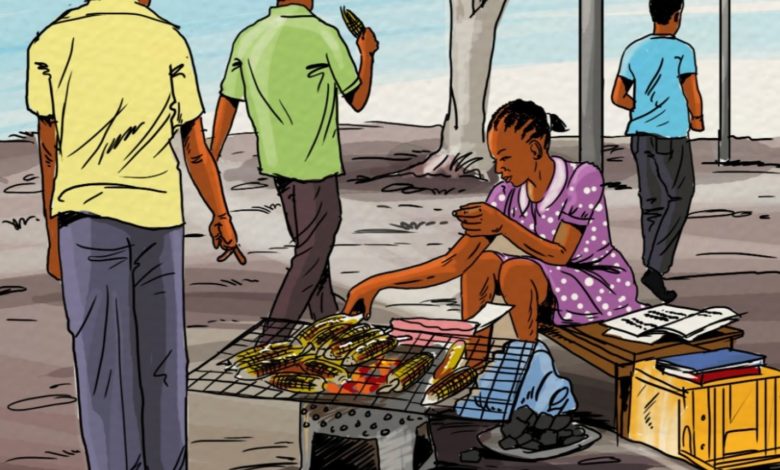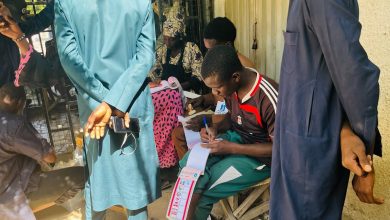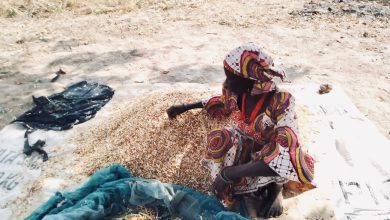SPECIAL REPORT: Why Empowerment Programmes Have Failed To Reduce Street Hawking In Lagos (PART 2)

Deborah, a secondary school student in a public school, sells vegetables on the street in the evening. The 17 years old has been trading since her primary school days to support her mother, who is engaged in the sale of all kinds of vegetables.
Deborah, over the years, has ensured that she is top of her class despite her having to combine study with trading.
” In my primary school, I was made the head girl and I moved on to becoming a prefect in my junior secondary school. I have been hawking since my primary school days and I still do to help my family, while my siblings learn other vocational trades,” she said.
Deborah like other child hawkers is not ignorant of the dangers involved in street hawking but is determined to sell off all her goods before going home.
Unemployment in Lagos
According to the National Bureau of Statistics 2020 second quarter report on unemployment, Lagos State with a population of 14 million has a labour force of over six million (6,831,870) compared to seven million in the third quarter of 2018 and 2017.
In the NBS 2017-2018 third quarter assessment, “Lagos State expectedly recorded the highest labor force population in the zone (as well as in the country). The population increased by 398,559 or 5.6 per cent, from 7,079,697 in Q3 2017, to 7,478,256.
“In Q3 2018, the unemployment rate dropped to 14.6 per cent (18.28 per cent in Q3 2017), while the underemployment rate.declined to 12.4 per cent, a decrease of 3.7 and 3.0 percentage points respectively. The total net (created minus lost) number of employed persons (full time and parttime/ underemployed) increased by 574,744 persons within Q3 2017 and Q3 2018,” NBS reported.
Despite the differences in the labour force records between 2017 and 2019, the state has consistently risen in unemployment rate.
Although the state is drastically below the benchmark of NIgeria’s 40.1 percent poverty index, the unemployment rate increased by 241,738 persons between 2018 Q3 and 2019 Q2, according to NBS.
The UN projected that 13 million jobs would be lost due to the COVID-19 pandemic.
Meanwhile, HumAngle investigations show that most people, including Lagos residents, are combining street trading with other jobs to make ends meet.
Child Labour Lagos
In 2012, the United Nations Children’s Fund, in a survey, put the total population of primary school age children in Lagos State at 1,223,027. In this population, 4.3 per cent were out of school, 21.1 per cent dropped out while 27.5 per cent were expected to never enter school.
Three years later (2015), the Lagos State House of Assembly called on the state
Governor, Mr Akinwunmi Ambode, to instruct concerned agencies to stop uncontrolled and unchecked street hawking by underage children.
The motion followed a resolution to remove all children on the streets, control the psychological trauma experienced and give a good picture about the state’s industrialisation.
Despite the right to basic education, Nigeria, in 2018, had about 13.2 million children out of school. The majority are in the Northern region due to insurgency and displacement of populations. Meanwhile, children in the Southwest region are made to struggle for survival.
The Universal Basic Education Commission said that Lagos State in 2019 had 418,237
children aged between six and 11 with a 20 per cent (84,247) out of school.
Research shows that in Nigeria many school age children hawk goods, travelling about 12 to 13 hours daily. The children hawk for the upkeep of themselves and their families, while others hawk for wages, or for people they live with outside their biological homes.
A child rights advocate and National Lead of Child First Nigeria, Peju Osoba, said, “Despite all that is being done, it is unfortunate that Nigeria still has a growing number of out of school children. As at November 2020, the number has grown to over 12 million.
“The insurgency in the Northeast and the effect of COVID-19 has not helped at all. Government response to the matter is slow and sometimes misdirected.
“The global economic downturn and the particular situation of Nigeria has further forced families to send their children to work in order to make up for family needs. Child headed families are beginning to emerge as parents are being killed in the Northeast.
“The fact that education being free remains on paper is another factor and for as long as there are no monitoring mechanisms for government policies, things will continue the way they are. Children are either completely out of school or majority of them are schooling and working. At present, statistics have it that about 43 per cent of Nigerian children are involved in one form of child labour or the other (USDOL report 2019).
“A child without access to education is being denied his right to development which is a basic right as enshrined in the constitution of Nigerian and the Child Rights Act of 2003. Any denial of right is tantamount to abuse. A child without education is not likely to understand that he has a right to be protested from abuse hence he is highly vulnerable. For as long as children are out of school and they engage in child labour, they will be exploited and exploitation is a form of abuse.”
ILO Conventions on Child Labour
The International Labour Organisation has two conventions to address child labour in countries. These conventions are fundamental and all ILO member states have an obligation to respect, promote and realise the abolition of child labour , even if they have not ratified the Conventions in question.
Convention No.138 on Minimum Age ensures that a child does not start working until they attain a legal age. The aim of ILO Convention No.138 on the minimum age is the effective abolition of child labour by requiring countries to: establish a minimum age for entry into work or employment; and establish national policies for the elimination of child labour.
Convention No. 182 on the Worst Forms of Child Labour helps to focus the international spotlight on the urgency of action to eliminate as a priority, the worst forms of child labour without losing the long term goal of the effective elimination of all child labour. Convention No. 182 requires countries to take ratifying countries to take immediate, effective and time-bound measures to eliminate the worst forms of child labour as a matter of urgency.
In October 2002, Nigeria ratified the specific minimum age to be 15 years and agreed to the provision of Convention 182.
Osoba noted that “the Child Rights Act and the Child Right Laws at the state level (25 states have domesticated it) are all laws. There is a national policy on child labour and a National Action Plan on the elimination of Child Labour. We have more than enough. Implementation and enforcement remain the critical issues in the fight against child labour.”
She suggested that the government must show commitment by monitoring the implementation of policies, enforcing laws and mobilising communities to ensure children are in school or learning skills.
Meanwhile, the adoption of Project Zero by the Lagos State government to tackle the problem of out-of-school children in the state still raised questions as to the effectiveness in reducing street hawking, she said.
- This story was supported by the US embassy via the ATUPA fellowship by Civic Hive
Support Our Journalism
There are millions of ordinary people affected by conflict in Africa whose stories are missing in the mainstream media. HumAngle is determined to tell those challenging and under-reported stories, hoping that the people impacted by these conflicts will find the safety and security they deserve.
To ensure that we continue to provide public service coverage, we have a small favour to ask you. We want you to be part of our journalistic endeavour by contributing a token to us.
Your donation will further promote a robust, free, and independent media.
Donate HereStay Closer To The Stories That Matter




